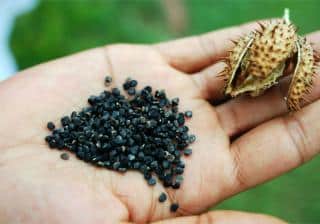

Brugmansia and Datura look alike, but they are actually different plants. Here are a few tricks to tell them apart.
Both are called “trumpet vines” in common language.
There are quite a few ways to tell Brugmansia and Datura apart. Here they are summarized in a short table:
| Part of the plant | Brugmansia | Datura |
| Flower | Dangling, hangs down from above | Upright, stands up from below |
| Flower color | White, peach, yellow | White, purple |
| Bearing | Shrub growing to a small tree | Low-lying, rarely exceeds a yard in height (1 m) |
| Stem or Trunk | Turns woody and thickens | Stays green and dies back |
| Seed pod | Smooth with pointed tips, shaped like bean pods |
Roundish with spikes on the husk, like a chestnut |
| Seed pod | Fuzz on the skin of the pod | No hairs or fuzz, slick skin |
| Seed spreading | Pod slits open, decays, seeds fall off |
Pod bursts open, seeds propelled to a distance |
Both Datura and Brugmansia belong to the same family, the Solanaceae family. They share certain attributes in common.
 Fragrance – both Datura and Brugmansia release a strong, heady fragrance that is delightful. In confined areas it can even become overpowering.
Fragrance – both Datura and Brugmansia release a strong, heady fragrance that is delightful. In confined areas it can even become overpowering.Note: if your toddler or child has eaten brugmansia or datura plant parts, get in touch with emergency or poison services in your area immediately.
Depending on the size of your garden, you might prefer either Brugmansia and Datura.
Brugmansia will grow rather large, up to several yards tall. It grows into a tree-like shrub.
You can guide it along a lattice to ensure it doesn’t fall over. This is especially relevant when growing it along a wall, where growth is imbalanced.
Datura stays rather small, and tends to send new branches out from the base when older ones die off.
Read also:
Your comment is awaiting moderation.
Dear sir or ma’am,
Can you show me how to tell abelia from weigela?